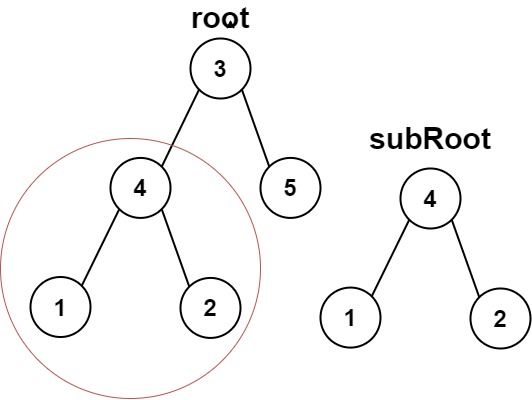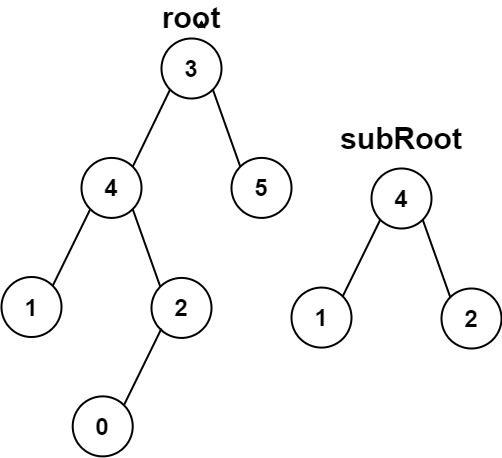Welcome to Subscribe On Youtube
572. Subtree of Another Tree
Description
Given the roots of two binary trees root and subRoot, return true if there is a subtree of root with the same structure and node values of subRoot and false otherwise.
A subtree of a binary tree tree is a tree that consists of a node in tree and all of this node's descendants. The tree tree could also be considered as a subtree of itself.
Example 1:

Input: root = [3,4,5,1,2], subRoot = [4,1,2] Output: true
Example 2:

Input: root = [3,4,5,1,2,null,null,null,null,0], subRoot = [4,1,2] Output: false
Constraints:
- The number of nodes in the
roottree is in the range[1, 2000]. - The number of nodes in the
subRoottree is in the range[1, 1000]. -104 <= root.val <= 104-104 <= subRoot.val <= 104
Solutions
-
/** * Definition for a binary tree node. * public class TreeNode { * int val; * TreeNode left; * TreeNode right; * TreeNode() {} * TreeNode(int val) { this.val = val; } * TreeNode(int val, TreeNode left, TreeNode right) { * this.val = val; * this.left = left; * this.right = right; * } * } */ class Solution { public boolean isSubtree(TreeNode root, TreeNode subRoot) { if (root == null) { return false; } return dfs(root, subRoot) || isSubtree(root.left, subRoot) || isSubtree(root.right, subRoot); } private boolean dfs(TreeNode root1, TreeNode root2) { if (root1 == null && root2 == null) { return true; } if (root1 == null || root2 == null) { return false; } return root1.val == root2.val && dfs(root1.left, root2.left) && dfs(root1.right, root2.right); } } -
/** * Definition for a binary tree node. * struct TreeNode { * int val; * TreeNode *left; * TreeNode *right; * TreeNode() : val(0), left(nullptr), right(nullptr) {} * TreeNode(int x) : val(x), left(nullptr), right(nullptr) {} * TreeNode(int x, TreeNode *left, TreeNode *right) : val(x), left(left), right(right) {} * }; */ class Solution { public: bool isSubtree(TreeNode* root, TreeNode* subRoot) { if (!root) return 0; return dfs(root, subRoot) || isSubtree(root->left, subRoot) || isSubtree(root->right, subRoot); } bool dfs(TreeNode* root1, TreeNode* root2) { if (!root1 && !root2) return 1; if (!root1 || !root2) return 0; return root1->val == root2->val && dfs(root1->left, root2->left) && dfs(root1->right, root2->right); } }; -
# Definition for a binary tree node. # class TreeNode: # def __init__(self, val=0, left=None, right=None): # self.val = val # self.left = left # self.right = right class Solution: def isSubtree(self, root: TreeNode, subRoot: TreeNode) -> bool: def dfs(root1, root2): if root1 is None and root2 is None: return True if root1 is None or root2 is None: return False return ( root1.val == root2.val and dfs(root1.left, root2.left) and dfs(root1.right, root2.right) ) if root is None: return False return ( dfs(root, subRoot) or self.isSubtree(root.left, subRoot) or self.isSubtree(root.right, subRoot) ) -
/** * Definition for a binary tree node. * type TreeNode struct { * Val int * Left *TreeNode * Right *TreeNode * } */ func isSubtree(root *TreeNode, subRoot *TreeNode) bool { if root == nil { return false } var dfs func(root1, root2 *TreeNode) bool dfs = func(root1, root2 *TreeNode) bool { if root1 == nil && root2 == nil { return true } if root1 == nil || root2 == nil { return false } return root1.Val == root2.Val && dfs(root1.Left, root2.Left) && dfs(root1.Right, root2.Right) } return dfs(root, subRoot) || isSubtree(root.Left, subRoot) || isSubtree(root.Right, subRoot) } -
/** * Definition for a binary tree node. * class TreeNode { * val: number * left: TreeNode | null * right: TreeNode | null * constructor(val?: number, left?: TreeNode | null, right?: TreeNode | null) { * this.val = (val===undefined ? 0 : val) * this.left = (left===undefined ? null : left) * this.right = (right===undefined ? null : right) * } * } */ const dfs = (root: TreeNode | null, subRoot: TreeNode | null) => { if (root == null && subRoot == null) { return true; } if (root == null || subRoot == null || root.val !== subRoot.val) { return false; } return dfs(root.left, subRoot.left) && dfs(root.right, subRoot.right); }; function isSubtree(root: TreeNode | null, subRoot: TreeNode | null): boolean { if (root == null) { return false; } return dfs(root, subRoot) || isSubtree(root.left, subRoot) || isSubtree(root.right, subRoot); } -
/** * Definition for a binary tree node. * function TreeNode(val, left, right) { * this.val = (val===undefined ? 0 : val) * this.left = (left===undefined ? null : left) * this.right = (right===undefined ? null : right) * } */ /** * @param {TreeNode} root * @param {TreeNode} subRoot * @return {boolean} */ var isSubtree = function (root, subRoot) { if (!root) return false; let dfs = function (root1, root2) { if (!root1 && !root2) { return true; } if (!root1 || !root2) { return false; } return ( root1.val == root2.val && dfs(root1.left, root2.left) && dfs(root1.right, root2.right) ); }; return dfs(root, subRoot) || isSubtree(root.left, subRoot) || isSubtree(root.right, subRoot); }; -
// Definition for a binary tree node. // #[derive(Debug, PartialEq, Eq)] // pub struct TreeNode { // pub val: i32, // pub left: Option<Rc<RefCell<TreeNode>>>, // pub right: Option<Rc<RefCell<TreeNode>>>, // } // // impl TreeNode { // #[inline] // pub fn new(val: i32) -> Self { // TreeNode { // val, // left: None, // right: None // } // } // } use std::rc::Rc; use std::cell::RefCell; impl Solution { fn dfs(root: &Option<Rc<RefCell<TreeNode>>>, sub_root: &Option<Rc<RefCell<TreeNode>>>) -> bool { if root.is_none() && sub_root.is_none() { return true; } if root.is_none() || sub_root.is_none() { return false; } let root = root.as_ref().unwrap().borrow(); let sub_root = sub_root.as_ref().unwrap().borrow(); root.val == sub_root.val && Self::dfs(&root.left, &sub_root.left) && Self::dfs(&root.right, &sub_root.right) } fn help( root: &Option<Rc<RefCell<TreeNode>>>, sub_root: &Option<Rc<RefCell<TreeNode>>> ) -> bool { if root.is_none() { return false; } Self::dfs(root, sub_root) || Self::help(&root.as_ref().unwrap().borrow().left, sub_root) || Self::help(&root.as_ref().unwrap().borrow().right, sub_root) } pub fn is_subtree( root: Option<Rc<RefCell<TreeNode>>>, sub_root: Option<Rc<RefCell<TreeNode>>> ) -> bool { Self::help(&root, &sub_root) } }